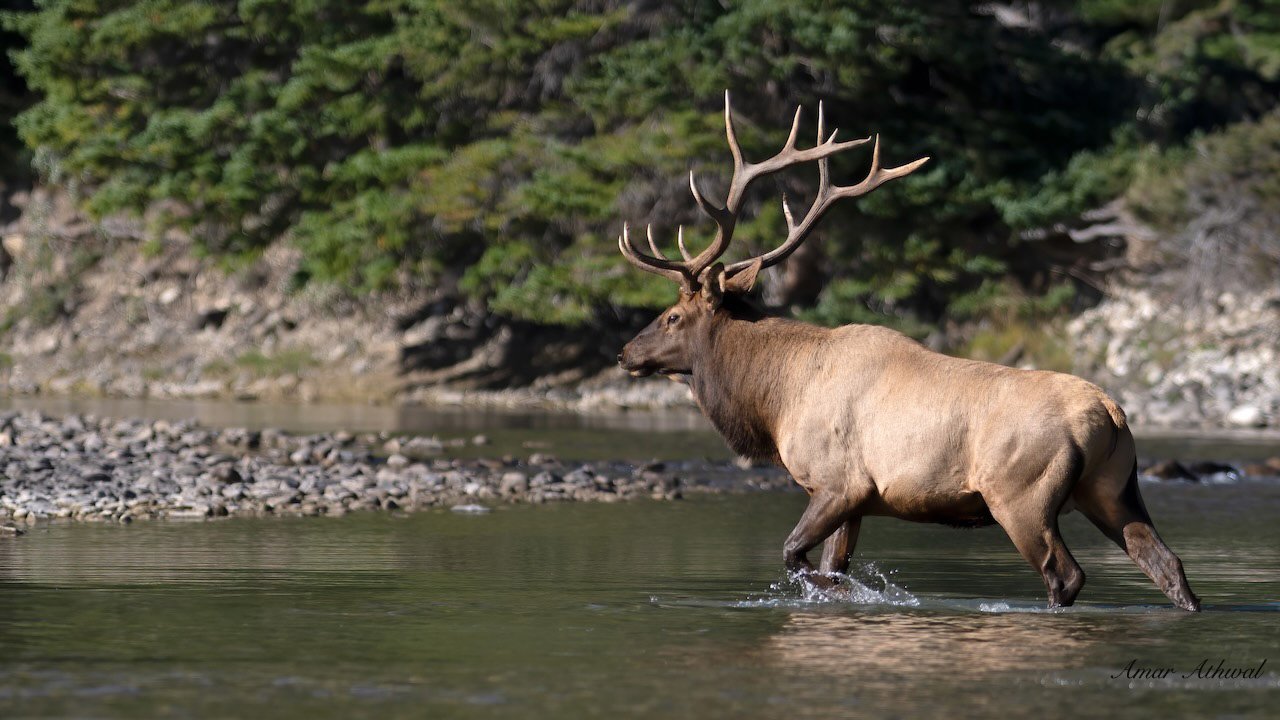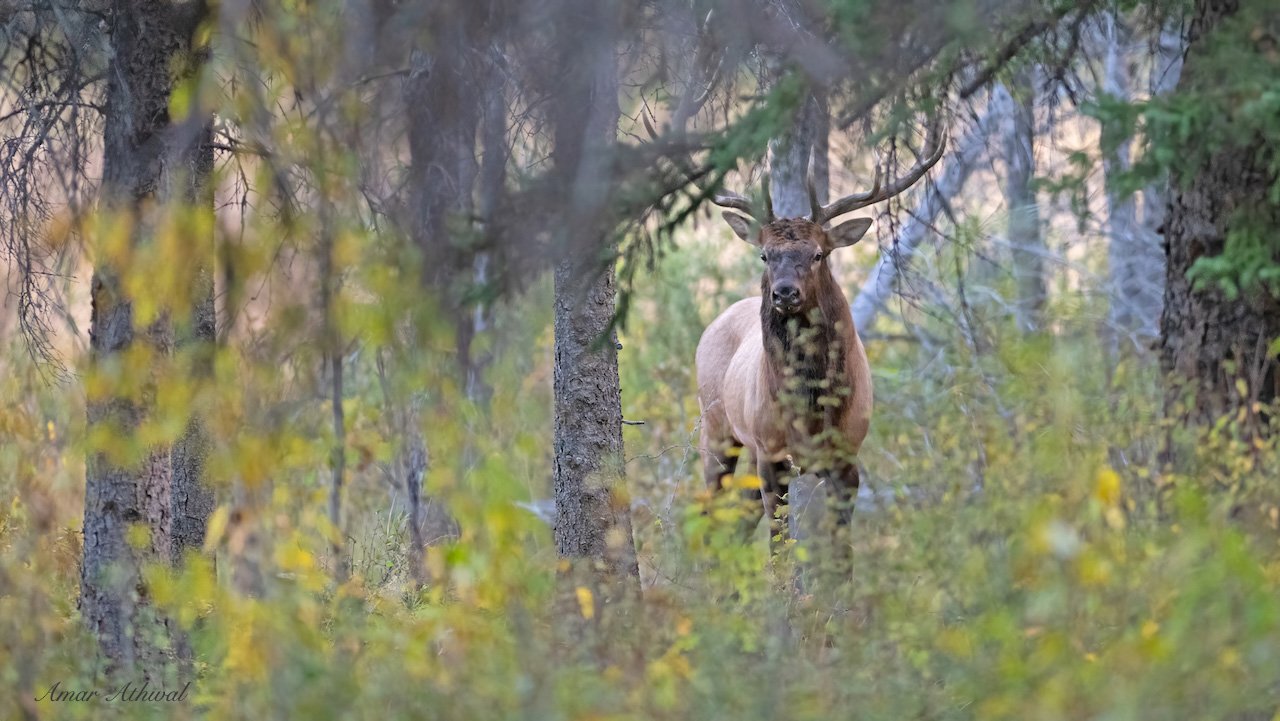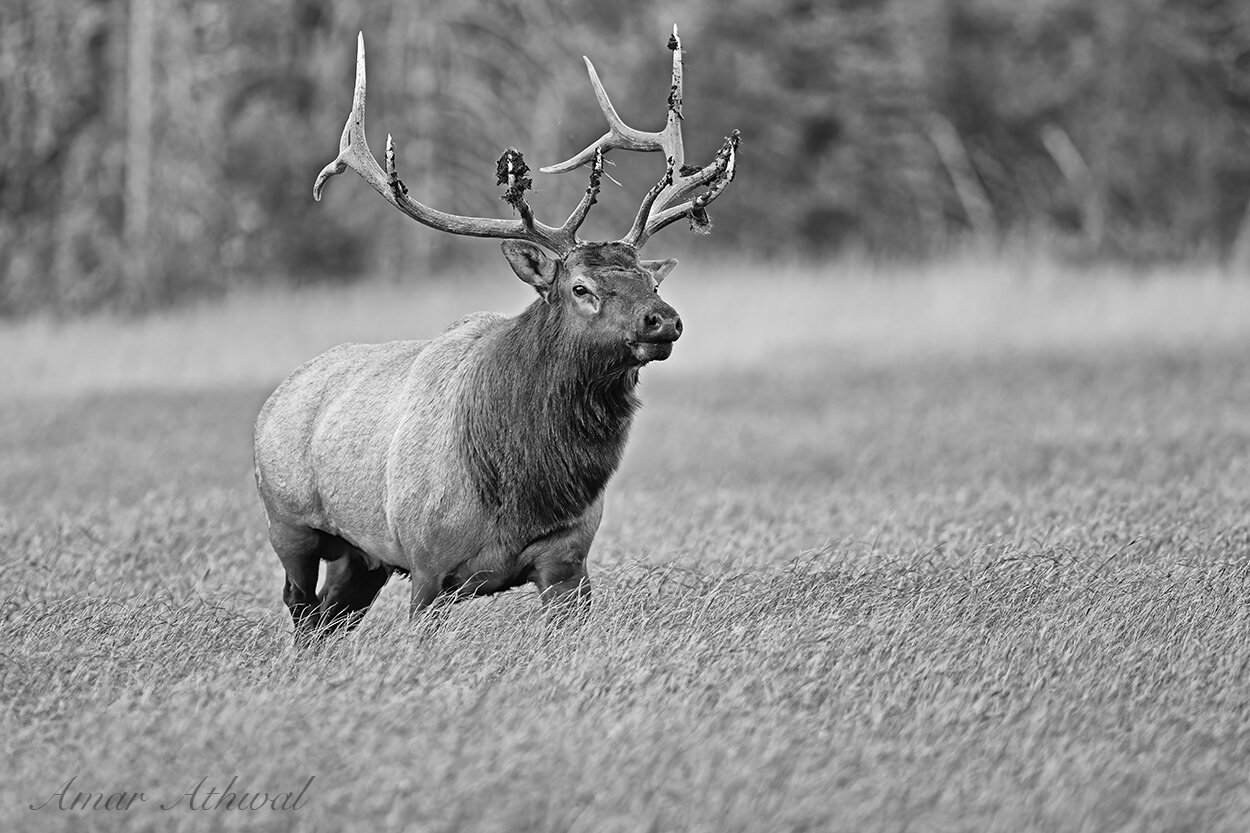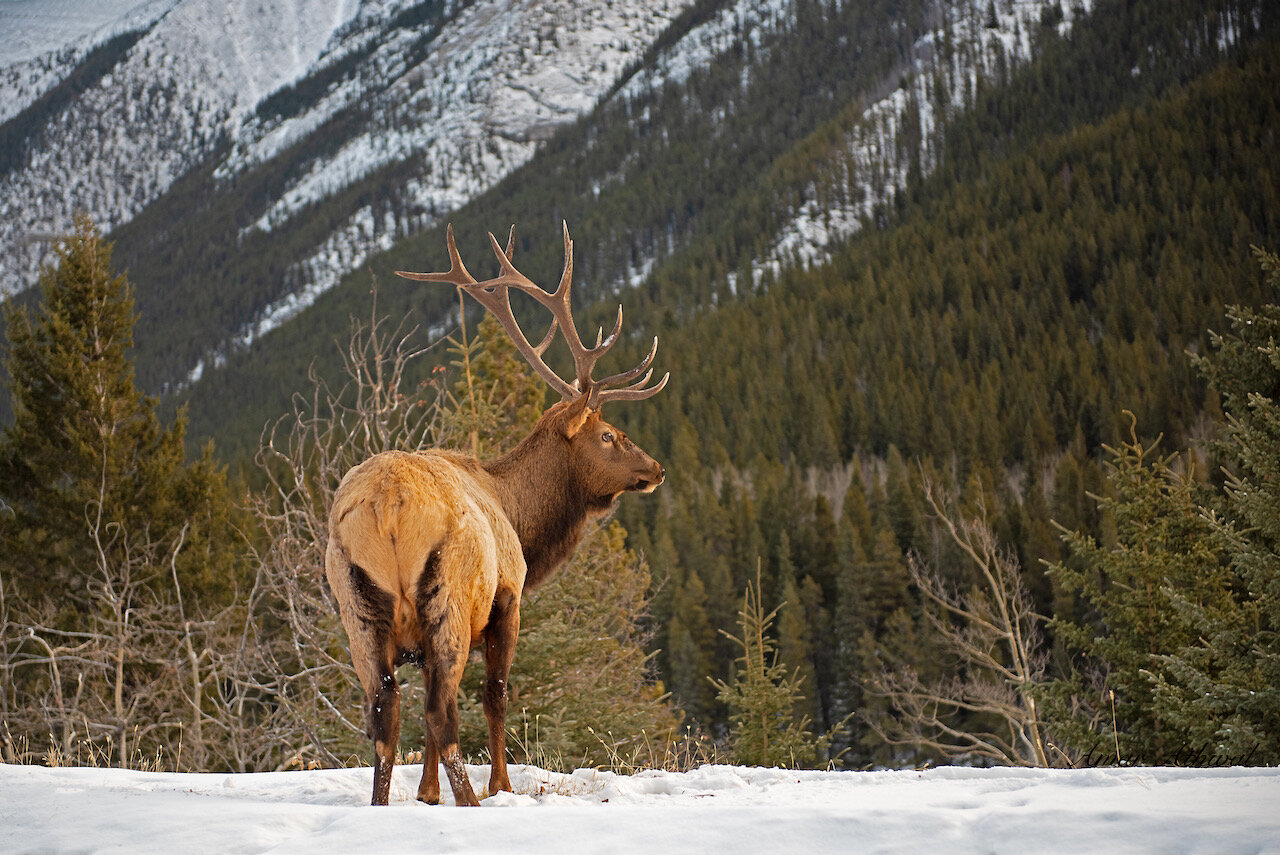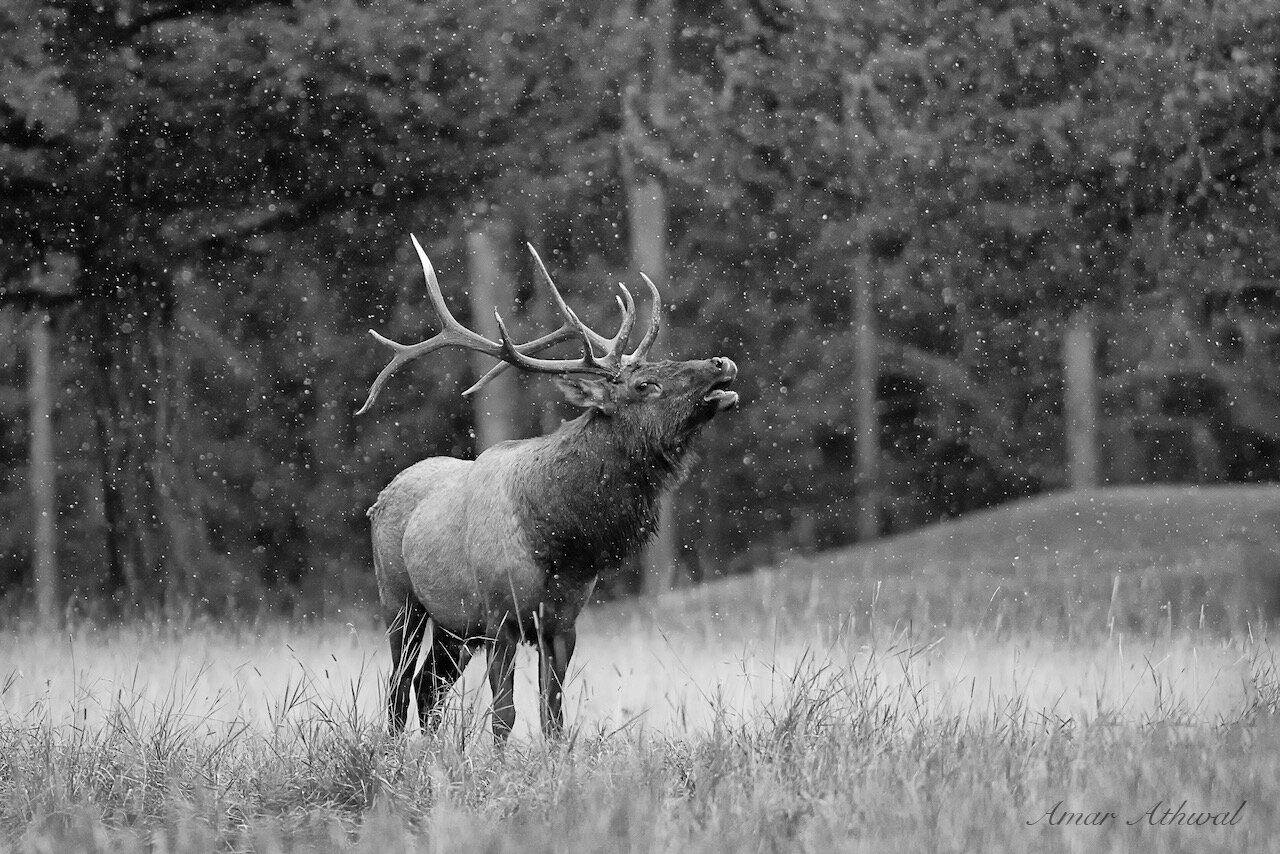This bull elk looked better when this picture was taken of him compared to the week before. He was still favoring his back right leg, but not as heavily as the previous week. With a lack of food during the winter, it's harder to recover from injuries than during the season of plenty. As well, even during this mild winter, the bull does not have a lot of energy to spare to heal. If this male, along with the four bachelors he was hanging out with, came across a wolf pack. All the bulls will show strength by standing tall, trying to look as big as they can, so they are not the ones to get attacked by the pack. And if everyone started running, each would again physically show strength, each one hoping not to be attacked. Even if our eyes can’t pick up any weakness between one elk compared to others, the wolves can. Sensing weakness through visual cues and through hearing and scent. In our homes our canine friends can use similar abilities to tell when we’re sick and, in some cases, before we become sick. For the wolves, their success rate in capturing prey is nowhere close to 100 percent. Depending on the location and type of prey, it can be less than 20 percent. So being able to pick the week from the strong increases their chances of having a meal sooner rather than later.
Elk
Another elk rut season ended a few weeks ago. The dominant bulls, like this one, started getting much-needed rest and, even more importantly, putting on the weight they lost during the rut season. The bulls that were successful during the mating season can, on average, lose up to 30 percent of their weight during the rut. But success during the rut season can lead to a shorter life for the bull. From injuries that the bull might have sustained fighting other bulls, being more vulnerable to predators before they recover from the rut season, or the cold weather arriving soon after the rut. The dominant males also lose the protection a herd offers after the rut. They either deal with the winter on their own or they join a few other males to deal with the winter. Including males, they were fighting during the rut. All is forgiven in the elk world, or at least until the next rut.
Elk
We are midway through the elk breeding season, or as it’s most often called the rut. As the days start getting shorter, it affects the melatonin levels in the elk. Melatonin is a hormone that the brain produces in response to darkness. It helps with our internal clock and with sleep. This in turn causes hormone changes in both bulls and cows. For the males at the start of the rut, the antlers mineralize and they shed the velvet. The males will start rubbing trees, to get rid of the velvet. They become more aggressive thanks to the higher testosterone levels during the rut and will start sparring with other males, against trees, shrubs and more.
This is why it’s even more important to be a safe distance from bulls during the rut season. By mid October, the bull’s testosterone level will go back to normal and once again the males will start hanging out with other males to pass the winter. This large bull was making sure I got home safe after work as he watched me through the woods.
Elk
Elk, like other members of the deer family, and bison, cattle, horses and many more have hooves. Which are like toenails and do not freeze. Hooves do not need a lot of blood supply, but the legs do. So they have a similar physiological adaptation as the birds, called a countercurrent exchange. Where the cold blood returns to the body right next to warm arterial blood moving down from the heart. Going back to the hooves, they act as an insulating layer between the legs and the frozen ground, snow or ice.
As well, to survive the winter, they have a thicker insulating coat. Made of two layers, a dense coat under long guard hairs. The guard hair looks like honeycomb, thousands of tiny air pockets fill each hair, helping them to be waterproof and warm. Every winter I have seen this heavy winter coat at work, being thick enough, the fallen snow on the elk will not melt. On very cold winter days, the thick coat reduces the amount of heat lost, by lying down. Less heat lost through their belly, chest and legs this way.
Elk will use stored fat to get through the winter, only around 30 percent of the winter energy requirement is met this way. Remaining energy comes from additional adaptations. Elk reduce their metabolism by one-third. They will also go into a dense stand of trees where possible, the trees hold warmer air near the ground and as well catch snow before falling on them and the ground they are on. As well, help reduce the wind speed. Some elk in the mountains will migrate to an area where terrain difference can help them reduce the amount of energy they need each day of winter.
For many animals, winter is a time of survival until spring brings all- you-can-eat buffet.
Elk
Rut in zoology means an annually recurring sexual excitement in animals during the mating season. Particularly in the deer family, which include elk. When the males are active. History of the world dates back to the early 15 century, from the Old French word rut (“noise, roar, bellowing”, ruit, from Late Latin rugitus, from rugire (“to roar”). The male in the picture had just gotten ready after rolling in mud and his urine, with his antlers all decorated. Bugling as he made his way to the ladies.
Elk
This bull and other male elk will start losing their antlers soon. This process happens each year at different times with the members of the deer family and with the caribou females. It’s a rare regeneration process among the mammals, which scientists are studying and hope to be able to duplicate in humans. Not to have antlers growing out of our heads, but to help nerves regenerate to return mobility to those with damaged limbs. The antlers are used to defend against competitors and to attract females and they are shed sometime after the mating season.
Replacement with new antlers start right away, with some moose they can be as heavy as 34 Kilograms. Growing antlers are surrounded by a fur called velvet, which carries all the material to build the bone. When the antlers are growing underneath the velvet, they are soft and can easily break. The animals will try not to damage them, the nerves in the velvet will provide the sensation to make sure the growing antlers are not banged or scratched until they stop growing and are hardened. Basically, with the nerves the animals will feel pain if the antlers feel pressure. In about three months the bone stops growing and they become sturdy. Blood flow stops and the velvet starts to break up. The males start feeling itchy, which gets them to start rubbing the antlers on branches, resulting in the velvet peeling off. Now they are ready to battle.
For the scientist the interesting part is the nerve that can grow to three feet long, these wiring is called axons, where information is transmitted. With antlers, the axons regrow each year, but not with humans when a limb has been damaged. By studying the members of the deer family, the scientists hope to understand the process and the material needed to duplicate it in humans who have damaged limbs or spinal cord injuries.
Elk
I don’t rely on friends and or colleagues giving me information about where the wildlife is or the best spot to get a picture of a sunrise. I learned many years ago, if you want to get into nature photography, then you need to get out. Now, I get a great amount of knowledge from my friends and or colleagues about the native flora and fauna, which I put toward the stories that go with my images. But to get the pictures I want. It’s simple, the more I stay out the more pictures I came back with. It’s a good thing I love exploring the mountains.
During the rut season, I like to get pictures but also learn what’s going on. Several times I had gone out to see this bull and its harem. I learned quickly its routine and was able to locate the harem. On this occasion I found them in tall grass, most still resting and few were eating. I kept my distance from the group and made sure I could easily back-out if needed. The male now and then would look toward me, but for the most part he went about his business. He was pretty laid back for a dominant male during the rut season. And I think it was the same male last year in the same area, the behaviour was the same. He did not tolerate any male elk of any age near his harem, otherwise members of his harem could wander off as far as a couple of hundred meters away. Also, he rested a lot when he was not battling small trees, it’s a great way to practice in case he had to battle another male. Many of the trees show the scars in the valley, form not only elk, but from other males of the deer family as well.
The rut season is still on, adding more chapters to this year’s drama and I getting a few more opportunities to learn and to take pictures.
Elk
The rut season is full on for the elk, Here's a male with an extra antler growing from the right side of his head. This can be caused by few reasons, genetics, hormone levels and or injury to the body or to the pedicle. Pedicle is the base where the antler grows from.
Elk
After being out there for 8 to 9 hours, birding for the day was coming to an end. It was time to go home and eat. On my way to the car on a trail through the woods, I saw elk moving across the open field and crossing the path ahead of me. They were in a hurry and even more so when they saw me. I stopped to watch a female with her week old calf trying to catch up. The mother was nervous and as a result, so was the calf. I stayed put, getting into a position to get the calf’s image as it moved through the tall grass. Once the two crossed the field, both ran through the trees to catch up.
Elk
Still some time before we see field of green, but the elk are startng to find green grass among the dry grass.
Elk
After the last snow storm few days back, winter got tougher for many of the wildlife. These male elk have to dig through all that snow and more to find food.
Elk
It was in the evening and the snow was falling. I decided to get out and to see if I could find a bull elk during the rut season to get a picture with the snow falling all around it. I cam across one bull, all by itself, but too far away for the picture. Half an hour later I saw a bull with its harem, I bundled up and got near where I was not in the way but I could see what was going front of me. The bull was bugling and walking back and forth, he was agitated. Just beyond him was an another bull with a smaller harem, who was also bugling. And to the right another adult bull, with one female and close by younger bulls. I kept looking around me, it was great listening to all the bugling, but I wanted to keep my safe distance from all of them. The bull farthest away, comes toward the bull in the middle, they walked side by side as if they were going to fight, but instead he took one of the female and moved back. The middle bull got more agitated, but would stay with his harem. A few minutes later this happened again. All three kept bugling, it was great to watch. Then the middle bull charged the bull to the right and toward the young bulls, all of them ran back and the middle bull returned to his harem with the one female.
It was great entertainment, but I had already got the picture I wanted. The middle ball in the clear, bugling with snow falling all around him. It was getting dark, time for me to leave and head home and let the rut continue during the night.
Elk
The rut season continues and this bull elk is busy as ever with its herm. Last week, during the evening I came across his herm, taking it easy and the bull was resting. But the rest was over, he got up and started bugling. He put on a nice show, but it started to get dark and it was time for me to leave.
Elk
Relatively speaking, it started out easier for the elk this winter. Not as cold and less snow on the ground. They still had to eat the same less nutritious food, no greens in the winter. But less snow to move aside to get at the food and less energy needed to get through the milder days and nights. But all that changed, snow storms started to come through and February brought with it much colder temperatures. Just like these three bulls, they have to spend more energy moving lots more snow to get at the less nutritious food and as well, losing lots more energy to survive the colder days and nights. Until spring arrives, they will be getting weaker, while their predators get stronger.
Elk
How time flies, it's that time of the year again. On Saturday, February the 2nd I'll be doing a slideshow presentation at the Cave and Basin NHS. Going over some of my favourite nature pictures from 2018 and the stories that go along with them. For $4.90 come spend couple of warm hours, from 7 to 9pm, sitting back and looking at flora, fauna and landscapes photos from the past year.
Elk
The rut season is over, the elk are taking advantage of the mild weather to gain weight. Particularly important for the dominant bulls. who lost 20 to 30 percent of their weight battling other bulls. The more weight the bulls gain, easier it will be getting through the winter.
Elk
The decibel level of elk bugling is 90 dB at 4 meters, lawnmower and food blender are two items that have similar sound levels. I have heard the bugling as far as 1 km away, with elk's larger ears, they would be able to hear the bugling from even further distance. this is important for the females who want to mate with a stronger male and help keeps weaker males away. Over 85 dB can lead to damage for human ears, another reason for us humans to keep our distance from wildlife. The recommend safe distance from elk i at least 30 meters. at that distance the bugling sound level comes to 72.5 dB. Close to the sound level when you're using a vacuum.
Elk
I came across this bull elk during a snow storm. I saw him with a small harem, away from any other males that might challenge him. He was still bugling, letting others know the harem was his.
Elk
The rut season is full on, the bulls can be head calling out throughout the Bow Valley. Here’s one of the bull with its harem I have been able to watch. The bull working to keep his harem together, calling out to attract more females and keep lesser males away. Still few weeks to go for the rut season, still time for other bulls to challange.
Elk and a Rainbow
Living in Banff National Park, nature is never far away. A bull elk hanging out at the rec grounds with a rainbow from of Mount Rundle.

